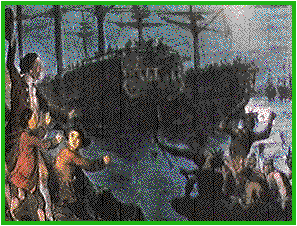In 1773, the East India Company had a lot of tea it could not sell in England and was almost ready to close down its business. To help save the company, the British Parliament passed the Tea Act of 1773. This allowed the company to sell its goods to the colonies without paying taxes. This meant the East India Company could sell their tea cheaper than the American merchants.
The Tea Act of 1773 did not impose any new tax on tea. It would still be taxed the three-penny per pound like it had been or the last six years. The British didn't think the colonists would be upset about the Act since by letting the East India Company not pay taxes, the price of tea would go down. But the colonists were angry because the Act would give the East India Company a monopoly on tea sales in the colonies.
The colonists became angry again about being taxed without representation. They decided to restart the boycott of tea. This time even more people joined the boycott. The women who drank most of the tea joined the boycott. The colonies united in a way they hadn't before.
Some of the colonies decided to stop the East India Company from docking their ships in colonial ports. In some ports East India Company agents were scared into resigning. Tea was returned to England or put in warehouses.
In October 1773, colonists in Philadelphia meet to discuss what they are going to do to oppose the tax and the East India Company monopoly. A committee then forces British tea agents to leave their positions.
In November the townspeople of Boston met and decided to follow what they did in Philadelphia. They try to get their British tea agents to resign, but they refused to leave their positions. Then three weeks later, three ships carrying tea from the East India Company sail into Boston harbor.
On November 29 and 30, 1773, the townspeople met two times to try to decide what to do about tea on three East India Company ships docked in the harbor. They decided to send the tea on one ship, the Dartmouth, back to England without paying the taxes. The Royal Governor of Massachusetts, Hutchinson, doesn't agree and orders the customs officials not to let the ship sail from the harbor unless the taxes are paid.
On December 16, 1773, Samuel Adams led three groups of fifty men dressed like Mohawk Indians and walked through the streets of Boston. Then someone blew a whistle. The men headed for the harbor and boarded the three ships with hatchets. They broke into 342 chests and threw all the tea overboard. (Most of the tea was a mixture of Ceylon and Darjeeling teas.) The amount of tea dumped into the harbor would make 24,000,000 cups of tea. Today, that much tea would cost about $1,000,000.00!
When they finished they marched back through the city and headed for the Liberty Tree. Other colonists followed and together they sang "The Liberty Song."
The tea washed up on the shore. The next morning the colonists went to the shore and crushed the tea leaves. Paul Revere rode through the cities telling everyone what had happened at the Boston Tea Party. As news traveled through the Colonies, other colonists decided to follow the example. Soon this became the destiny of most East India Company's ships that decided to force their way into harbors.
The people of Boston refused to pay for the tea they had destroyed. This angered King George III. To punish the colonies, especially Massachusetts, the Parliament acted by creating the Coercive or Intolerable Acts. These acts only sparked new resistance up and down the colonies.





